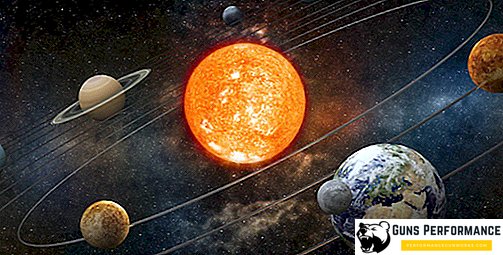
Gravity is the most powerful force in the Universe, one of the four fundamental foundations of the universe, which determines its structure. Once, thanks to her, planets, stars, and whole galaxies arose. Today it keeps the Earth in orbit on its never-ending journey around the Sun.
The attraction is of great importance for the daily life of man. Thanks to this invisible power, the oceans of our world pulsate, rivers flow, rain drops fall to the ground. Since childhood, we feel the weight of our body and surrounding objects. The influence of gravity on our economic activity is immense.
The first theory of gravity was created by Isaac Newton at the end of the XVII century. His Law of Worldwide describes this interaction within the framework of classical mechanics. More widely this phenomenon was described by Einstein in his general theory of relativity, which was released at the beginning of the last century. The processes occurring with the power of the elementary particles should explain the quantum theory of gravity, but it has yet to be created.
Today we know about the nature of gravity much more than at the time of Newton, but, despite centuries of study, it still remains a real stumbling block of modern physics. In the existing theory of gravity, there are many white spots, and we still do not exactly understand what causes it, and how this interaction is transferred. And, of course, we are very far from being able to control the force of gravity, so that anti-gravity or levitation will long exist only in the pages of science fiction novels.
What fell on Newton's head?
People thought about the nature of force, which attracts objects to the ground at all times, but Isaac Newton managed to lift the veil of secrecy only in the seventeenth century. The basis for his breakthrough laid the works of Kepler and Galileo - brilliant scientists who studied the movements of celestial bodies.
Another one and a half century before the Newtonian Law of the World, the Polish astronomer Copernicus believed that attraction is "... nothing but the natural tendency with which the father of the Universe gifted all particles, namely to unite into one whole, forming spherical bodies". Descartes considered attraction as a consequence of perturbations in the world ether. The Greek philosopher and scientist Aristotle was convinced that the mass affects the speed of falling bodies. And only Galileo Galilei at the end of the XVI century proved that this is not true: if there is no air resistance, all objects are accelerated in the same way.

Contrary to the common legend about the head and the apple, Newton went to understanding the nature of gravity for more than twenty years. His law of gravity is one of the most significant scientific discoveries of all times and peoples. It is universal and allows you to calculate the trajectories of celestial bodies and accurately describes the behavior of objects around us. The classical theory of heaven laid the foundations of celestial mechanics. Newton's three laws gave scientists the opportunity to discover new planets literally "at the tip of the pen," after all, thanks to them, man was able to overcome earth gravity and fly into space. They brought a strict scientific base under the philosophical concept of the material unity of the universe, in which all natural phenomena are interconnected and controlled by general physical rules.
Newton did not just publish a formula to calculate the force that attracts bodies to each other, he created a complete model, which also included mathematical analysis. These theoretical conclusions have been repeatedly confirmed in practice, including using the most modern methods.
In Newtonian theory, any material object generates a field of attraction, which is called gravitational. Moreover, the force is proportional to the mass of both bodies and inversely proportional to the distance between them:
F = (G m1 m2) / r2
G is the gravitational constant, which is 6.67 × 10−11 m³ / (kg · s²). He was first able to calculate Henry Cavendish in 1798.
In everyday life and in applied disciplines, the force with which the earth attracts the body is referred to as its weight. The attraction between any two material objects in the Universe is what gravity is in simple words.
The force of attraction is the weakest of the four fundamental interactions of physics, but thanks to its features it is able to regulate the motion of stellar systems and galaxies:
- The attraction works at any distance, this is the main difference between gravity and strong and weak nuclear interactions. With increasing distance, its action decreases, but it never becomes zero, so we can say that even two atoms at different ends of the galaxy have a mutual effect. It is just very small;
- Gravity is universal. The field of attraction is inherent in any material body. Scientists have not yet discovered on our planet or in space an object that would not participate in the interaction of this type, so the role of gravity in the life of the Universe is enormous. This is different from the electromagnetic interaction, the effect of which on space processes is minimal, since in nature most bodies are electrically neutral. Gravitational forces cannot be limited or screened;
- It acts not only on matter, but also on energy. For him, the chemical composition of objects does not matter, only their mass plays a role.
Using Newton's formula, the force of attraction can be easily calculated. For example, the gravity on the moon is several times smaller than that on Earth, because our satellite has a relatively small mass. But it is enough to form regular ebbs and flows in the oceans. On Earth, the acceleration of free fall is approximately 9.81 m / s2. And at the poles, it is somewhat larger than at the equator.

Despite the enormous importance for the further development of science, Newton's laws had a number of weak points that did not give rest to the researchers. It was not clear how gravity acts through an absolutely empty space for enormous distances, and at an inconceivable speed. In addition, data gradually began to accumulate that contradicted Newton's laws: for example, the gravitational paradox or the displacement of the perihelion of Mercury. It became obvious that the theory of universal aggression requires refinement. This honor fell to the lot of the brilliant German physicist Albert Einstein.
Attraction and Theory of Relativity
Newton's refusal to discuss the nature of gravity (“I do not invent hypotheses”) was an obvious weakness of his concept. Not surprisingly, in the following years, many theories of gravity appeared.
Most of them belonged to the so-called hydrodynamic models, which tried to justify the emergence of a mechanical interaction of material objects with some intermediate substance that has certain properties. Researchers called it differently: "vacuum", "ether", "graviton flux", etc. In this case, the force of attraction between the bodies arose as a result of a change in this substance, when it was absorbed by objects or screened flows. In reality, all such theories had one serious drawback: rather accurately predicting the dependence of the gravitational force on distance, they had to lead to the deceleration of bodies that moved relative to the “ether” or “graviton flux”.
Einstein approached this issue from a different angle. In his general theory of relativity (GTR), gravity is viewed not as an interaction of forces, but as a property of spacetime itself. Any object having a mass leads to its curvature, which causes attraction. In this case, gravity is a geometric effect, which is considered in the framework of non-Euclidean geometry.
Simply put, the space-time continuum affects matter, causing its movement. And that, in turn, affects the space, "pointing" him how to bend.

The forces of attraction act in the microcosm, but at the level of elementary particles their influence, as compared with the electrostatic interaction, is negligible. Physicists believe that the gravitational interaction was not inferior to the others in the first moments (10 -43 sec.) After the Big Bang.
At present, the concept of gravity, proposed in the general theory of relativity, is the main working hypothesis accepted by the majority of the scientific community and confirmed by the results of numerous experiments.
Einstein in his work foresaw the amazing effects of gravitational forces, most of which have already been confirmed. For example, the possibility of massive bodies to bend light rays and even slow down the passage of time. The latter phenomenon is necessarily taken into account when operating global satellite navigation systems such as GLONASS and GPS, otherwise in a few days their error would be tens of kilometers.
In addition, the consequence of Einstein's theory are the so-called subtle effects of gravity, such as the gravity-magnetic field and the inertia of inertial reference systems (also known as the Lense-Thirring effect). These manifestations of force are so weak that for a long time they could not be detected. Only in 2005, thanks to NASA’s unique Gravity Probe B mission, the Lense-Thirring effect was confirmed.
Gravitational radiation or the most fundamental discovery of recent years
Gravitational waves are oscillations of a geometric space-time structure, propagating at the speed of light. The existence of this phenomenon was also predicted by Einstein in general relativity, but due to the weakness of the force, its magnitude is very small, therefore it could not be detected for a long time. Only indirect evidence spoke in favor of the existence of radiation.
Such waves generate any material objects moving with asymmetric acceleration. Scientists describe them as "space-time ripples." The most powerful sources of such radiation are colliding galaxies and collapsing systems consisting of two objects. A typical example of the latter case is the fusion of black holes or neutron stars. In such processes, gravitational radiation can pass more than 50% of the total mass of the system.

Gravitational waves were first discovered in 2015 using two LIGO observatories. Almost immediately, this event received the status of the largest discovery in physics in recent decades. In 2017, the Nobel Prize was awarded for him. After that, scientists have several times been able to fix the gravitational radiation.
Back in the 70s of the last century — long before experimental confirmation — scientists suggested using gravitational radiation to carry out long-distance communications. Its undoubted advantage is the high ability to pass through any substance without being absorbed. But at the present time it is hardly possible, because there are enormous difficulties with the generation and reception of these waves. Yes, and real knowledge about the nature of gravity is not enough.
Today, there are several installations in different countries around the world, similar to LIGO, and new ones are being built. It is likely that in the near future we will learn more about gravitational radiation.
Alternative theories of world wideness and the reasons for their creation
Currently, the dominant concept of gravity is GR. It agrees with the entire existing array of experimental data and observations. At the same time, it has a large number of overtly weak points and controversial points, therefore attempts to create new models explaining the nature of gravity do not cease.
All the theories of world wide perception that have been developed so far can be divided into several main groups:
- standard;
- alternative;
- quantum;
- single field theory.
Attempts to create a new concept of world wide were made in the XIX century. Various authors included the ether or the corpuscular theory of light. But the advent of the GR put an end to these explorations. After its publication, the goal of scientists has changed - now their efforts were aimed at improving the Einstein model, including new natural phenomena in it: the back of particles, the expansion of the Universe, etc.
By the beginning of the 1980s, physicists experimentally rejected all concepts, except for those that included GTR as an integral part. At this time, came into vogue "string theories", which looked very promising. But an experienced confirmation of these hypotheses have not been found. Over the past decades, science has reached significant heights and has accumulated a vast array of empirical data. Today, attempts to create alternative theories of gravity are inspired mainly by cosmological research related to such concepts as "dark matter", "inflation", "dark energy".
One of the main tasks of modern physics is the unification of two fundamental directions: quantum theory and general relativity. Scientists seek to associate attraction with other types of interactions, thus creating a “theory of everything”. This is exactly what quantum gravity is doing - a branch of physics that is trying to give a quantum description of gravitational interaction. A branch of this direction is the theory of loop gravity.
Despite active and long-term efforts, this goal has not yet been achieved. And the matter is not even in the complexity of this task: it is simply that the basis of quantum theory and GR is completely different paradigms. Quantum mechanics works with physical systems acting against the background of ordinary space-time. And in the theory of relativity, space-time itself is a dynamic component, depending on the parameters of the classical systems that are in it.
Along with the scientific hypotheses of the world, there are also theories that are far from modern physics. Unfortunately, in recent years, such "opus" just flooded the Internet and shelves of bookstores. Some authors of such works generally inform the reader that gravity does not exist, and the laws of Newton and Einstein are inventions and mystifications.
An example is the work of the “scientist” Nikolai Levashov, who asserts that Newton did not discover the law of the world, and only the planets and our moon, the moon, have gravitational force in the solar system. Evidence of this "Russian scientist" leads quite strange. One of them is the flight of the American NEAR Shoemaker probe to the asteroid Eros, which took place in 2000. The absence of attraction between the probe and the celestial body Levashov considers evidence of the falsity of Newton's works and the conspiracy of physicists who hide the truth about gravity from people.
In fact, the spacecraft successfully completed its mission: first, it went into the asteroid orbit, and then made a soft landing on its surface.
Artificial gravity and why it is needed
Two concepts are associated with gravity, which, despite their current theoretical status, are well known to the general public. This antigravity and artificial gravity.
Antigravity is the process of counteracting the force of gravity, which can significantly reduce it or even replace it by repulsion. Mastering this technology would lead to a real revolution in transport, aviation, the exploration of outer space and radically changed our whole life. But at present, the possibility of anti-gravity does not even have a theoretical confirmation. Moreover, based on GTR, this phenomenon is not at all feasible, since there can be no negative mass in our Universe. It is possible that in the future we will learn more about gravity and learn how to build aircraft based on this principle.

Artificial gravity is a man-made change to the existing force of gravity. Today, we don’t need such technology, but the situation will definitely change after the start of long-term space travel. And the thing is our physiology. The human body, "accustomed" by millions of years of evolution to the constant gravity of the Earth, is extremely negative about the effects of reduced gravity. Long stay even in the conditions of lunar gravity (six times weaker than the earth's) can lead to sad consequences. The illusion of attraction can be created using other physical forces, such as inertia. However, these options are complex and expensive. В настоящий момент искусственная гравитация не имеет даже теоретических обоснований, очевидно, что ее возможная практическая реализация - это дело весьма отдаленного будущего.
Сила тяжести - это понятие, известное каждому еще со школьной скамьи. Казалось бы, ученые должны были досконально исследовать этот феномен! Но гравитация так и остается глубочайшей тайной для современной науки. И это можно назвать прекрасным примером того, насколько ограничены знания человека о нашем огромном и замечательном мире.












